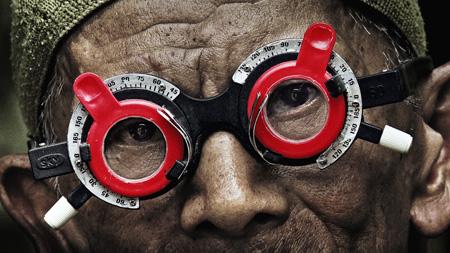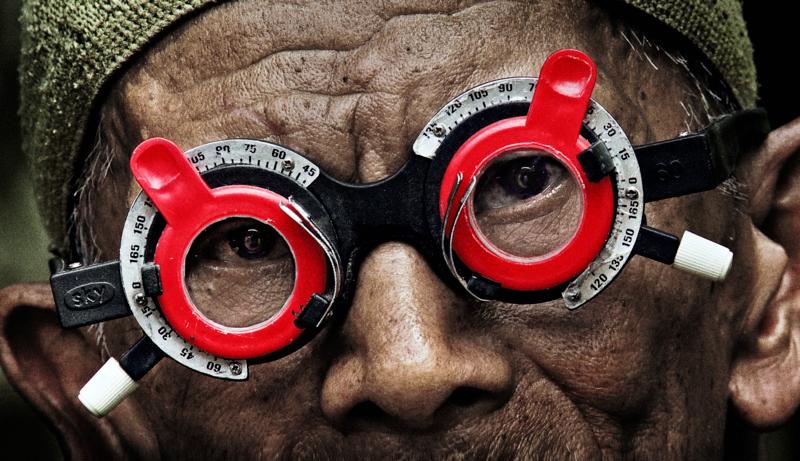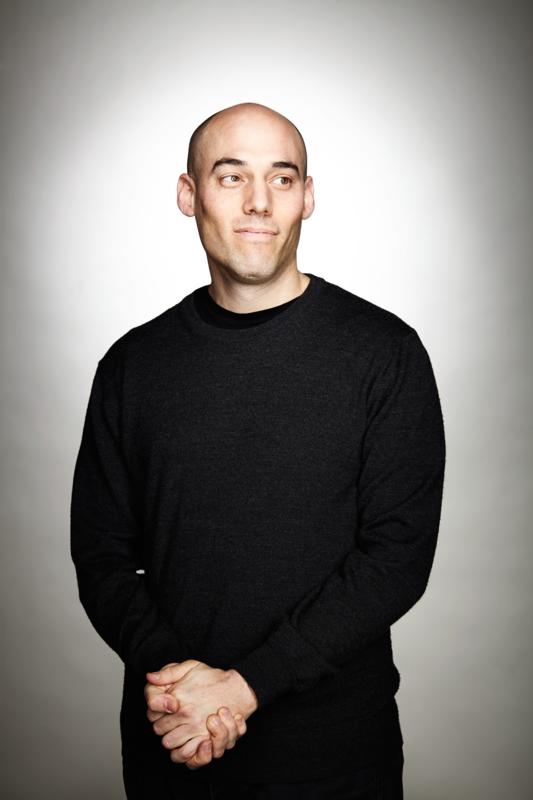Last year, as "The Act of Killing" swept its way around the world, we were treated to a radical demonstration in the partialities, the pretences and the instabilities of history. Rarely has the word of the winners been shown up on film in such naked ugliness and ongoing mendacity. Finding, in a corner of the fourth most populous country in the world, that the poor were still too terrified and persecuted to speak out against ongoing exploitation, nearly half a century after an estimated minimum of a million suspected leftists had been slaughtered in a military-led purge, Joshua Oppenheimer instead trained his lens on the people who would speak freely: the now-aged perpetrators of those killings, who still rule the roost by boasting about their bloody triumphs, with the implication that they would and could repeat the feats if it were deemed necessary.
When Oppenheimer came across a group of former killers who were also movie mad, with ideas of their own about how to write history on screen, the square was circled. As Anwar and company let their mouths run and the cameras roll, they began to see themselves as we would begin to see them; the more layers of rationalisation, justification, dissimulation and unspeakable truth they wrapped around the film, the more there was to uncover. The resulting movie was traumatically eye-opening for just about everyone involved, including most of us tied to such a country by trade and political alliance. And, of course, as much as the film exposed such a polity, it also challenged it.
Before he left Indonesia for good (he no longer feels safe returning), Oppenheimer filmed a second movie; less than six months after accompanying "The Act of Killing" to the Oscars, he was ready to unveil "The Look of Silence" at the Venice and Toronto film festivals. As promised, this would be a counterpart to "The Act of Killing", a film about the victimised families of the 1965 massacres to mirror the prior film about the perpetrators. He had conceived of the idea while editing "The Act of Killing":
"Especially in my longer original cut, almost every disturbing sequence ends in an abrupt cut to an almost silent landscape, usually with a lone figure. I had this feeling that every time we would make these abrupt shifts from Anwar's dialogue scenes to these tableaux, we were also abruptly shifting the perspective of the film, creating these haunted spaces to honour and commemorate the absent dead."
"And," he continues, "I had the feeling there was another film to be made, equally contemporary, in which we enter those silent tableaux and imagine what it would be like to have to build a life here out of the rubble, to have to survive surrounded by these perpetrators who are still in power."
As for finding a protagonist – someone brave enough to speak truth to Indonesian power; someone not content to suffer in silence with the label of "victim" – Oppenheimer had already met his man.
The Worm Turns
Oppenheimer first came to Indonesia in 2001 to make The Globalisation Tapes, whose account of union struggles and free-market militarism introduced him to the fear that still shrouds the country. There was one name that always came up – "as almost synonymous with the genocide, a kind of synecdoche for 1965. I gradually came to understand the reason was that his death had witnesses."
Like tens of thousands of others, Ramli had been abducted at night and taken down to Snake River to be killed and dispatched into the waters. But Ramli managed to escape, wounded; after a commotion in the road, he had crawled all the way back home to his parents, where his killers again found him; claiming that they would take him to hospital (and threatening otherwise to round up the rest of the family), they left him for dead at a nearby creek because it was nearing daybreak, only to be called back again by passersby who'd seen him struggling and calling for help. Finally, we're told in another boastful confessional scene which Oppenheimer had recorded long back in 2003, his killers cut off his penis and left him for dead in the plantation in which Oppenheimer filmed" The Globalisation Tapes".
"Ramli," says Oppenheimer, "was somehow irrefutable proof of the events that had traumatised everybody – that everybody knew about but that the regime at least officially had threatened everyone into pretending had not occurred. To talk about Ramli was almost to pinch yourself to remind yourself you’re awake; to remember the truth."
Ramli's parents, Rohani and Rukun, had one more child after Ramli died; we see Rohani reminding him that he was to be Ramli's replacement, the only thing to save her sanity. Adi, as Oppenheimer tells it, grew up different from the others: surrounded by fear, but not afraid like his remaining elder siblings, who had all witnessed Ramli's abduction and murder; burdened but empowered by his mother's words; angry at the victim-blaming lies taught him in school, and now taught his children; determined to educate himself out of poverty; "questing" in his desire to understand what had really happened in 1965 and why.
Adi was one of the original contacts who suggested, in 2003, that Oppenheimer open his camera to the killers – and would help him find them, including the two who owned up to Ramli's killing. And he would watch the resulting footage intently, even when Oppenheimer's investigations took him away from the plantation villages to Medan and the gangsters who would become the focus of "The Act of Killing". "He'd react with outrage, sadness," says Oppenheimer. "I remember him saying, 'This is the tiger that's sleeping just under the floor in Indonesia' – an image of repression, of something potent just under the surface."
Come 2012 and Oppenheimer's return to shoot his companion piece, it was Adi who suggested, rather than simply reprise their efforts to gather survivors on camera, that they film Adi meeting Ramli's killers. Amir Hasan, the presiding executioner, had died since confessing for Oppenheimer's camera in 2003, but they identified five who were still alive, able to talk and directly connected to the killings in Ramli's village.
So just as "The Act of Killing" served as its own making-of, recording what happened as Anwar shot its scenes ("the method begets the story", as Oppenheimer summarises), so "The Look of Silence" proceeds from its own making, with Adi watching Oppenheimer's old footage in which killers confess, then paying them a visit. It's a narrative straight out of wish-fulfilment fiction – the return/revenge-of-the-repressed archetypes of "High Plains Drifter", or "The Bride Wore Black" – and like almost nothing in factual cinema.
As Oppenheimer says, "I had this feeling we were entering totally uncharted waters. I can’t think of another film in which a survivor of political violence, or a relative of a victim, confronts a perpetrator while the perpetrators are still in power."
All Asunder
This unbroken ground was disorienting for everyone involved. Oppenheimer describes the precautions Adi, he and his producer Signe Byrge Sørensen took before each set-piece interview – taking no Indonesian crew and no ID other than mobile phones with only the numbers of their respective embassies stored; readying two getaway cars to mislead any would-be pursuers, and having their bags packed so they could all leave immediately for the airport. "They’re the ones who’ve committed crimes, but we were the ones seen as bandits," he agrees.
As for Adi: "You just felt he was absolutely saying the unsayable, right to their faces," says Oppenheimer. "One way he's able to get away with it of course is his own quiet and calm, his empathy and dignity." At one point in the film he even hazards telling the leader of the Komando Aksi death squads, who is trying to back down from his earlier boasts, "I think you’re trying to avoid your moral responsibility." In another confrontation, the head of the local legislature threatens: "If you keep making an issue of the past – it will definitely happen again."
"What can I say – those were frightening moments," says Oppenheimer. "I was often asked by audiences about 'The Act of Killing': wasn't I afraid, shooting it? And really the only times were when the perpetrators themselves would doubt what they were doing. But in this one, getting to those moments was the crux of the movie. So yes, we were afraid."
Yet if they feared for their footing, so too did their hosts. "As with 'The Act of Killing', one of the reasons perpetrators don't want to look honestly at what they've done, and its meaning, is because they wouldn't be able to live with themselves any more," says Oppenheimer. "Also, of course, there's a fear of revenge. And then, they were presumably confused: this man is speaking like a victim accusing us, but he's with Joshua – and they knew me, and knew I'd been working with their commanders and other powerful perpetrators. So what is happening here? I think that gave them second thoughts, if they were considering reacting violently in the moment. I had this feeling we were entering totally uncharted territory in these meetings, and they were astonished."
What Lies Beneath
As with "The Act of Killing", Oppenheimer has not only provoked and exposed a politically and emotionally shattering situation through his work with striking and tragic characters, but found startlingly bold images with which to film it. One are the optical lenses with which Adi fits his interviewees while asking them to tell their stories: Adi trained as, of all things, an optician, and as we see at the start of the film spends many of his working days travelling to old people's homes and asking them about the past while testing their eyes.
Another visual motif is that of jumping beans, with which Adi's children play, and which bookend the film. Oppenheimer cites a couple of other favourite shots: light streaming through the clapboards of Adi's parents' house at night ("this sense of pressure, this energy inside"), and an overtaking motorbike carrying a burlap sack stuffed with live ducks, their heads hanging out and squawking ("a sense of contained energy, anguish, multitudes").
The magic beans had reminded Oppenheimer of earlier thoughts, at the beginning of his Indonesian sojourn, of Macondo in Gabriel García Márquez's "One Hundred Years of Solitude": "the massacre that just makes sense of everything you'd read up until the point that it's spoken about; the vortex around which the whole book swirls. Magical realism is perhaps the only genre for dealing with atrocity in the context of total impunity. Because of the sorcery and magic that becomes inevitable when you have repression and horror. Because things haunt. Ghosts are abroad."
After the Battle
Next year will mark the 50th anniversary of Indonesia's genocide. Oppenheimer talks about "The Act of Killing" having helped open a space in which Indonesians could speak the truth about their history in public – though not one the government has yet made use of, beyond a cursory acknowledgement, prompted by the film's Oscar nomination, that wrongs were done, though reconciliation will come when the government so chooses.
This film, he hopes, will help people make the most of that space: "to have an easier time making a difference; to make the need for truth, and of reconciling the country to its past, something irrefutable among ordinary Indonesians, just as 'The Act of Killing' was an object lesson in the need for justice, of the dangers of impunity and the moral vacuum to which total impunity leads.
"And what we see in Adi's almost failed and tragic mission," he adds, "is that that process is not going to come from one individual" – any more than it can be dictated from above. "There was a truth and reconciliation process in South Africa because the apartheid regime fell. There were the Nuremberg trials because the Nazis lost. That's not going to happen in Indonesia until there's real social change."
At the same time, the film's aims are deeper than either advocacy or therapy: it is art before it is a tool.
"Documentaries dealing with atrocities far too often tell us there's going to be some truth commission, some campaigning human-rights advocates, and we can trust in them, or in justice, or in the outrage of the audience, to put things right," says Oppenheimer.
"I think the point is that nothing will be put right. You have to move on, but you can’t fix everything that's been destroyed, all the opportunities, the hope and the lives lost. I hope this film leaves an indelible sense that the damage done to the survivors' families, to their lives, is irreversible, that nothing will wake the dead."
The article was first published in FILM Digital Fall Issue 2014. "The Look of Silence", selected for Masters at IDFA, is produced by Signe Byrge Sørensen for Final Cut for Real.




